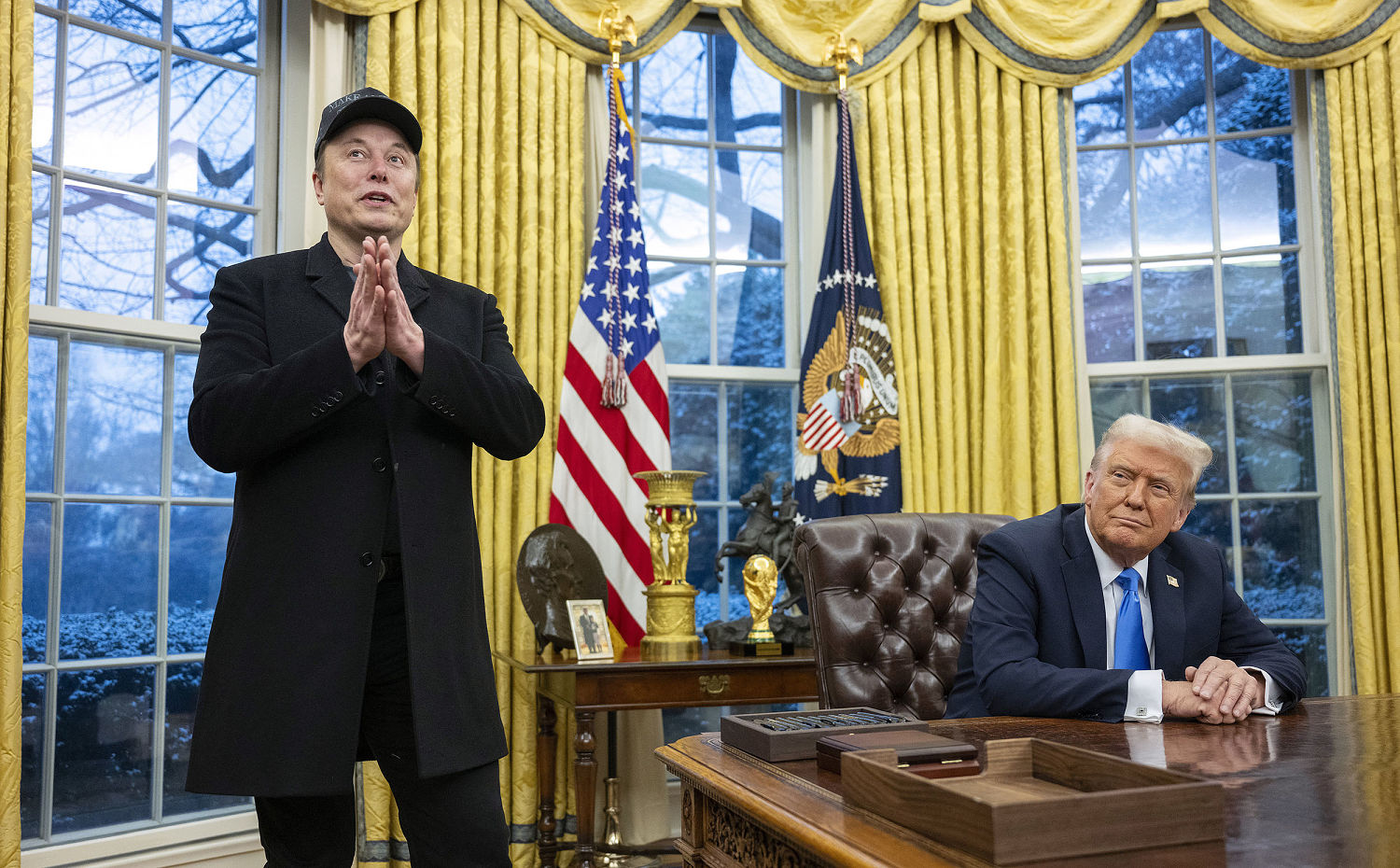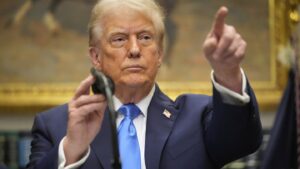The Dictatorship
Social Security is the latest front in Trump and Musk’s attack on trust in government

Standing next to President Donald Trump in the Oval OfficeElon Musk conjured an image of a Social Security system riddled with fraud that was as vivid as it was make-believe. For example, Musk said that large numbers of 150-year-olds are receiving Social Security benefits. But, as Wired notedwhen recipients’ birth dates are default or incomplete, the programming language that Social Security’s benefits system was written in defaults to 1875. What Musk came across was a programming quirk, not fraud.
But since Musk is now one of the key nodes of the right’s ever-mightier misinformation machine, his falsehood was quickly spread to untold millions as more (fake) evidence that the federal government is a mess. And it gets worse: The Social Security Administration’s top official, Michelle King, a civil servant with decades of experience, resigned in protest after a confrontation in which she refused to give the so-called Department of Government Efficiency access to the incredibly sensitive information about every American stored in Social Security’s databases.
Trump has always both exploited and encouraged distrust in government.
It’s not clear whether DOGE now has that access, or what they would do with it. And if that makes you deeply uneasy, know that that anxiety is perfectly fine with the Trump administration.
In the 1960s, as much as three-quarters of the public told pollsters they trusted the government to do what is right either most of the time or always; today that number sits in the low 20s. The reasons for the decline are complex, but Trump has always both exploited and encouraged distrust in government; the fact that it is so widespread is a key reason he is president right now.
Yet if electing Trump is a symptom of distrust toward the government, the early days of his administration indicate he will give Americans even more reason to believe that the government can’t solve problems, doesn’t keep its promises, and never deserves the benefit of the doubt.
Among the victims of this alternately haphazard and malevolent approach is a group that voted overwhelmingly for Trump. Farmers who signed contracts with the government to begin conservation and renewable energy projects on their land, that obligated the government to reimburse them for the cost of those projects, have seen the funds frozen. That leaves them holding the bag for loans they took out and money they invested on the assumption that the government would keep its end of the agreement. One farmer told The New York Times he would “never do anything with any government agency ever again.”
This story is playing out with various government programs across the country. Small nonprofits that receive federal funds to provide services like Head Start or rides for the elderly to dialysis treatment have had to lay off workers or shut down entirely because of the funding freeze. The Solar For All program had signed contracts worth $7 billion with states, localities and nonprofits to set up community solar projects; the Trump administration froze the funds and left many projects in limbo. Last week, the administration essentially shut down the Consumer Financial Protection Bureau, leaving consumers more vulnerable to financial scams. And the White House plans to lay off thousands of IRS workers, which will likely reverse the progress the agency had recently made in improving customer service.
The next Democratic president and Congress will have an enormous challenge.
These are just a few of the actions the administration has taken, but the result will be the same: a government that gives people poorer service, can’t be trusted to keep its word, and isn’t there when we need it. In the future, how many people will want to enter into contracts with the government like the ones those farmers did? How many talented and idealistic young people will choose to go into public service after watching thousands of civil servants summarily fired?
This is a tragic irony of the destruction currently in progress: A genuine, good-faith effort to improve government efficiency could save money, help Americans by improving the delivery of services and boost people’s faith in government. It would be an extremely worthwhile undertaking; there is plenty of room for improvement in how the federal government operates. This administration, however, is not operating in good faith, and it seems determined to give people more reasons to believe that government can’t do anything right.
Many conservatives dislike government for ideological reasons; whether it does its job well or poorly, they’ll still say they don’t trust it. But there are millions of Americans who judge government based on what they’ve heard and what they’ve experienced. Long after Trump and Musk are done slashing and burning their way through Washington, their suspicions will remain.
That means the next Democratic president and Congress will have an enormous challenge when they try to make the case that government can be an ally rather than an impediment. Not only will they face the practical task of rebuilding what Trump and Musk have destroyed, they’ll have to rebuild trust as well — and that could be even harder.
The Dictatorship
Dr. Trump? The president reprises his COVID era

WASHINGTON (AP) — President Donald Trump isn’t a doctor. But he played one on TV Monday, offering copious amounts of unproven medical advice that he suggested — often without providing evidence — might help reduce autism rates.
Trump repeatedly implored pregnant women to avoid taking the painkiller Tylenol, the bestselling form of acetaminophen. That’s despite the American College of Obstetricians and Gynecologists long recommending acetaminophen as a safe option during pregnancy. He even weighed in on when children should be given painkillers.
Speaking alongside Health and Human Services Secretary Robert F. Kennedy Jr., himself a vaccine skepticTrump stopped short of opposing all vaccines. But he said key immunizations should be delayed, or combination shots should be given separately — even though it has been proven that vaccines have no link to autism.
“Don’t let them pump your baby up with the largest pile of stuff you’ve ever seen in your life,” he said.
Trump also wildly overstated how such shots — some of which protect against four diseases — are given.
“I think it’s very bad. They’re pumping, it looks like they’re pumping into a horse,” Trump said. “You have a little child. A little fragile child. And you’ve got a vat of 80 different vaccines, I guess, 80 different blends, and they pump it in.”
Dr. Trump redux
The presentation recalled the early days of the coronavirus pandemic during Trump’s first term, when the president stood for daily White House briefings and tossed out grossly inaccurate claims — including famously suggesting that injecting disinfectants could help people.
“I see the disinfectant that knocks it out in a minute, one minute. And is there a way we can do something like that by injection inside, or almost a cleaning?” Trump asked in April 2020. “As you see, it gets in the lungs, it does a tremendous number on the lungs, so it would be interesting to check that.”
He later claimed he’d been joking, but those briefings soon stopped. His tone stayed serious Monday.
The president suggested unspecified problems with the the safe and effective MMR — measles, mumps and rubella — vaccine and advised parents to wait years later than now, until age 12, for hepatitis B vaccines to be given to children.
The theme he hit harder than any other, though, was declaring a supposed link between autism and acetaminophen, which is known in most countries outside the U.S. as paracetamol. Trump repeated, “Don’t take Tylenol,” with increasing urgency and eventually shouted it.
Tylenol maker Kenvue disputed any link between the drug and autism and said in a statement that if pregnant mothers don’t use Tylenol when in need, they could face a choice between suffering potentially dangerous fevers or using riskier painkiller alternatives.
Trump, Kennedy and many of the administration’s top health officials all spoke, but largely repeated known statistics rather than new research findings. Trump appeared to acknowledge that science might not be on his side, saying at one point, “I’m just making these statements from me.”
“I’m not making them from these doctors,” the president conceded. “Cause when they, uh, talk about, you know, different results, different studies, I talk about a lot of common sense. And they have that, too. They have that too, a lot.”
But then he later insisted he’d “spoken to many doctors about everything we’re talking about.”
Many scientists were appalled
“The announcement on autism was the saddest display of a lack of evidence, rumors, recycling old myths, lousy advice, outright lies, and dangerous advice I have ever witnessed by anyone in authority in the world claiming to know anything about science,” Arthur Caplan, of the New York University School of Medicine’s Division of Medical Ethics, said in a statement. “What was said was not only unsupported and wrong but flat out malpractice in managing pregnancy and protecting fetal life.”
Ahead of the autism event, Trump had suggested that his administration had discovered new medical links that would dramatically explain why its rates have risen. But his preparation didn’t include learning how to pronounce acetaminophen, which tripped him up.
“Asedo … well, let’s see how we say that. Acid em … menophin,” Trump stammered before continuing, “Acetaminophen? Is that OK?”
Trump also insisted there was “no downside” to Americans heeding his advice “other than a mother will have to, as I say, tough it out a little bit” and avoid Tylenol for pain while pregnant.
“Everything I said, there’s no downside to doing it,” Trump said. “It can only be good.” Still, untreated fevers in pregnancy, particularly the first trimester, increase the risk for miscarriages, preterm birth and other problems, according to the Society for Maternal-Fetal Medicine.
The president tried to head off such criticism by blaming pharmaceutical companies and “maybe doctors” for having suppressed critical medical information previously. He said his statements were based on “the information that we have.”
“I’m making them out front, and I’m making them loud,” Trump said. “And I’m making them strongly.”
The Dictatorship
Federal judge lifts administration halt of offshore wind farm in New England

WASHINGTON (AP) — A federal judge ruled Monday that a nearly complete offshore wind project halted by the administration can resume, dealing President Donald Trump a setback in his ongoing effort to restrict the fledgling industry.
Work on the nearly completed Revolution Wind project for Rhode Island and Connecticut has been paused since Aug. 22 when the Bureau of Ocean Energy Management issued a stop-work order for what it said were national security concerns. The Interior Department agency did not specify those concerns at the time. Both the developer and the two states sued in federal courts.
Danish energy company Orsted and its joint venture partner Skyborn Renewables sought a preliminary injunction in U.S. District Court that would allow them to move forward with the project.
At a hearing Monday, Judge Royce Lamberth said he considered how Revolution Wind has relied on its federal approval, the delays are costing $2.3 million a day and if the project can’t meet deadlines, the entire enterprise could collapse. After December, the specialized ship needed to complete the project won’t be available until at least 2028, he said. More than 1,000 people have been working on the wind farm, which is 80% complete.
“There is no question in my mind of irreparable harm to the plaintiffs,” Lamberth said, as he granted the motion for the preliminary injunction. In his written ruling, he said Revolution Wind had “demonstrated likelihood of success on the merits” of its claim, adding that granting the injunction is in the public interest.
Interior Department spokeswoman Elizabeth Peace said the ruling means Revolution Wind “will be able to resume construction” while the Bureau of Ocean Energy Management “continues its investigation into possible impacts by the project to national security and prevention of other uses on the Outer Continental Shelf.”
The administration said in a court filing this month that while BOEM approved the wind farm, it stipulated that the developer continue to work with the Department of Defense to mitigate national security concerns. It said the Interior Department, to date, has not received any information that these concerns have been addressed.
Orsted said Monday that construction will resume as soon as possible, and it will continue to seek to work collaboratively with the administration.
Nancy Pyne of the Sierra Club said the court ruling “reaffirms that Donald Trump and his administration’s attacks on clean energy are not only reckless and harmful to our communities, but they are also illegal.” Trump is trying to “kneecap” renewable energy “in favor of dirty and expensive fossil fuels,” she said.
White House spokeswoman Anna Kelly said Trump was elected with a mandate to “restore our country’s energy dominance — which includes prioritizing the most effective and reliable tools to power our country. This will not be the final say on the matter.”
On the campaign trail, Trump vowed to end the offshore wind industry as soon as he returned to the White House. He wants to boost production of fossil fuels such as oil, natural gas and coal, which emit greenhouse gases that cause climate change, in order for the U.S. to have the lowest-cost energy and electricity of any nation in the world, he says.
His administration has stopped construction on major offshore wind farmsrevoked wind energy permits and paused permittingcanceled plans to use large areas of federal waters for new offshore wind development and stopped $679 million in federal funding for a dozen offshore wind projects.
Last week, the administration moved to block a separate Massachusetts offshore wind farm. That was just days after the Interior Department asked a federal judge in Baltimore to cancel previous approval to build an offshore wind project in Maryland.
Revolution Wind is supposed to be Rhode Island’s and Connecticut’s first large offshore wind farm, capable of supplying power to more than 350,000 homes, about 2.5% of the region’s electricity needs.
Connecticut Attorney General William Tong and Rhode Island Attorney General Peter Neronha, who are both Democrats, called the judge’s ruling a major win for workers and families, who need the project to stay on track so it can start to drive down unaffordable energy bills.
Connecticut Rep. Joe Courtney, a Democrat, said a multibillion-dollar project that is 80% complete and was fully permitted with input by the Pentagon is not a national security problem. The Interior Department “should take the hint and let the thousands of construction workers finish the job,” he said.
Orsted began construction in 2024 about 15 miles (24 kilometers) south of the Rhode Island coast. It says in its complaint that about $5 billion has been spent or committed, and it expects more than $1 billion in costs if the project is canceled. Rhode Island is already home to one offshore wind farm, the five-turbine Block Island Wind Farm.
___
McDermott reported from Providence, Rhode Island. AP Writer Susan Haigh in Hartford, Connecticut, contributed to this report.
___
The Associated Press’ climate and environmental coverage receives financial support from multiple private foundations. AP is solely responsible for all content. Find AP’s standards for working with philanthropies, a list of supporters and funded coverage areas at AP.org.
The Dictatorship
Trump wants to redistribute billions that were taken from California’s high-speed railroad

The Trump administration wants to redistribute $2.4 billion it pulled from California’s high-speed rail project as part of a new $5 billion program announced Monday to fund rail projects to boost passenger rail traffic nationwide.
The new program’s rules for states and others wanting to participate remove any mention of diversity or climate change dating to the Biden administration. The new program will also put a priority on projects in areas with higher rates of birth and marriage and projects that improve safety at railroad crossings.
The Trump administration has removed climate change and so-called DEI language from other grant requirements, and Transportation Secretary Sean Duffy took a jab at that Biden-era language and California Gov. Gavin Newsom’s rail project in his announcement.
“Our new National Railroad Partnership Program will emphasize safety – our number one priority – without the radical … DEI and green grant requirements. Instead of wasting dollars on Governor Newsom’s high-speed rail boondoggle, these targeted investments will improve the lives of rail passengers, local drivers, and pedestrians,” Duffy said.
The biggest chunk of this money the Federal Railroad Administration announced comes from the $4 billion that was pulled from the California project. The rest of the money comes from a combination of what was announced last year and what is in this year’s budget.
President Donald Trump and Duffy have both criticized the decades-old California project for its cost overruns and many delays that have kept the train that’s designed to connect San Francisco and Los Angeles from becoming a reality.
California officials said they will fight the effort to redistribute money they believe should be going to their project. They had already filed a lawsuit challenging the Trump administration’s decision to pull federal funding from the rail project.
“The FRA’s decision to terminate federal funding for California high-speed rail was unlawful, unwarranted, and is being challenged in federal court. Now, their attempt to redirect a portion of that funding, currently the subject of litigation, is premature,” said Micah Flores, a spokesman for the California High-Speed Rail Authority. “The Authority has been prepared for this possibility and will take imminent legal action to block this misguided effort by the FRA.”
The focus on areas with higher birth and marriage rates reflects Trump’s executive orders that make spending that benefits American families a priority in his administration, according to an FRA spokesman.
The Federal Railroad Administration said railroad crossings are important to address because more than 200 people a year are killed when trains collide with vehicles or pedestrians at crossings. That has long been something the government and railroads have worked to address, but it is costly to build bridges or underpasses that allow cars to safely bypass the tracks.
Even though the money is targeted toward improving passenger rail, some of it will almost certainly go to improvements on the nation’s major freight railroads because Amtrak uses their tracks for most of its long-distance routes across the country.
The administration also said it would give priority to projects that improve the traveling experience for families by adding amenities like nursing mothers’ rooms, expanded waiting areas and children’s play areas in train stations.
Applications for this money are due by Jan. 7.
___
Associated Press writer Sophie Austin contributed to this report from Sacramento, California.
-
Uncategorized11 months ago
Bob Good to step down as Freedom Caucus chair this week
-

 The Josh Fourrier Show11 months ago
The Josh Fourrier Show11 months agoDOOMSDAY: Trump won, now what?
-

 Politics7 months ago
Politics7 months agoFormer ‘Squad’ members launching ‘Bowman and Bush’ YouTube show
-

 The Dictatorship7 months ago
The Dictatorship7 months agoPete Hegseth’s tenure at the Pentagon goes from bad to worse
-

 Politics11 months ago
Politics11 months agoWhat 7 political experts will be watching at Tuesday’s debate
-

 The Dictatorship7 months ago
The Dictatorship7 months agoLuigi Mangione acknowledges public support in first official statement since arrest
-

 Politics11 months ago
Politics11 months agoHow Republicans could foil Harris’ Supreme Court plans if she’s elected
-

 Politics7 months ago
Politics7 months agoBlue Light News’s Editorial Director Ryan Hutchins speaks at Blue Light News’s 2025 Governors Summit










